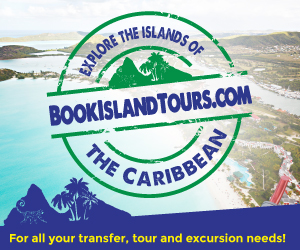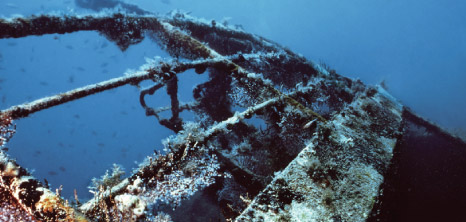|
ShipwrecksBarbados has a reputation for being the home of the healthiest reefs in the Caribbean and an island that offers the ideal opportunity for wreck diving.
Barrier reefs are located approximately two and one-half miles from the shore, and are renowned for the large coral heads forming the habitat for thousands of varied multi-colored tropical fish.
Predominantly made up of coral formations, Barbados is surrounded by coral reefs of many different shapes, sizes and semblences. Based on the vast marine life and many wrecks on the island, this makes the island a sought-after spot for divers as these wrecks now make up the natural scenery for marine life. These very beautiful and unspoilt reefs off Barbados are prolific with marine life that serve to intrigue any amateur or professional diver. Summertime is the best time to see Barbados' coral reefs in their prime.
It's been recorded that Carlisle Bay has lost approximately 200 ships since the 17th Century due to storms or pirating but Barbados has just about 10 recorded wrecks to choose from. No doubt, there are many more out there patiently awaiting the arrival of brave souls to discover and explore their very existence.
Shipwrecks in BarbadosCarlisle Bay ShipwrecksThis ideal dive location is home to a variety of wrecks and offers perfect conditions for beginner divers. Here, they can find tropical fish, eels, frog fish, seahorses among many others. Of exceptional interest are the following four wrecks - the Berwyn, Eilon, C-Trek and Fox.
Berwyn (Carlisle Bay - World War 1 French) Berwyn sits 7-10 feet below the water's surface dependent on the level of the tide at the time. This tug boat was sunk in 1919 by its own crew. Two very key factors have contributed to this wreck being quite healthy and attracting as much marine life as it does and those are the age of the actual wreck and the fact that its waters are always quite calm.
Ce-Trek (Carlisle Bay) This concrete structure now serves as an abandoned boat which was sunk in 1986. The waters surrounding this particular shipwreck are deep and though accessible by freediving, greater benefits are had by way of scuba diving.
Eillon (Carlisle Bay) Scuba divers love this particular shipwreck due to its easy access. It's a 110 ft long drug boat that was sunk on June 8th, 1996 after being tied up at the Bridgetown Careenage for 6 years.
Bajan Queen (Carlisle Bay) A bit of history on the Bajan Queen indicates that her original name was the 'Pelican' back in 1960 when the Bridgetown Harbour underwent construction. Some 10 years later, the Pelican was converted to a party boat and renamed the Bajan Queen due to the introduction of more modern tugboats. Years later after living out its time as a party spot on the island, the Bajan Queen was donated to the Coastal Zone Management Unit. The Bajan Queen was subsequently sunk on May 19th, 2002 and now rests a mere few feet below the water's surface.
Cornwallis (Carlisle Bay) During World War II, this Canadian freighter was sunk by a torpedo from a German U-Boat. The relocation of this shipwreck took place on October 22, 2003 from a very high boat traffic region of the bay to Carlisle Bay.
Barge (Carlisle Bay) This naval landing barge has certainly provided a home for scores of reef fish including the porcupine fish which is cousin to the puffer.
Friars CragResting in 55ft of water approximately 1 mile off the South Coast of Barbados, this magnificient reef offers a sight to behold in a 100ft Dutch freighter that was sunk in 1984. Hawksback turtles, tropical fish, blue tang, squirrel fish, peacock flounders, crab, lobster and the occasional sting ray are all part of the picturesque scenery this wreck has to offer.
In 2004, unfortunately due to the passing of tropical storm Ivan, massive coral damage was experienced at this site but since then it has been restored by Mother Nature to what it is today.
SS Stavronikita (the Stav)In 1976, a 365ft Greek freighter was burnt severely off the coast of Barbados. It was towed back to Bridgetown, where it stayed for about 2 years.
In 1978, the Stav was bought over by the Government of Barbados and deliberately sunk just off Fitts Village, St. James for the sole purpose of creating an artificial reef. This artificial reef is now home to a great number of fish and coral alike. The Stavronikita rests in 120ft of water and is said to be one of the best wreck dives the island has to offer.
PamirThis particular wreck is located to the North of Barbados and is approximately 165ft long and 60 ft deep. Based on its coordinates, it is considered perfect for those beginner divers.
Barbados ReefsBell BuoyBell Buoy, as the name aptly suggests, is a bell shaped coral reef near Accra Beach on the island of Barbados with a brown coral forest. Viewed as one of the islands' most popular diving sites, this massive coral reef has a shallow depth of approximately 30 - 70 ft and is ideal for beginners and intermediate divers alike.
There is an abundance of marine life on this reef inclusive of but not limited to angel fish, chromis, parrot fish and multitudes of gorgonian coral trees. When married with the natural bright sunlight, its shallow depth makes it an enviable place for photography.
Bonita BarVisits to this particular reef are infrequent by divers as it is a bit deeper than the other reefs. It starts at approximately 50 ft and drops off to approximately 100 ft.
Bright LedgeLocated near Heywoods Beach in the parish of St. Peter at varied depths of 50 - 200 ft, this truly brilliant coral Jigsaw has come alive with vibrant colours, a great variety of marine life and many corals and sponges. Barracudas, nurse sharks, manta rays, moray eels, jacks, French angel fish and even the endangered Hawksbill turtles can be readily seen frequenting this coral reef.
Church PointThis typical west coast reef comes to within 20ft of the water's surface. In the advent of unstable weather conditions, this could be a bit problematic as the reef would now become very susceptible to damage caused by wind surges.
DottinsThis other popular west coast dive site has a reputation for being the best place for night diving. Its south side has a profusion of creole wrasse and yellow tail snappers, while its north side is scattered with sand patches and Sting Rays that are often time seen gently swimming across the ocean floor This coral reef has diving depths ranging from less than 40ft - 100ft and thus is a good diving site for beginners and intermediate divers.
It is particularly known as a habitat for barracudas. The south side of Dottins is marked by an abundance of creole wrasse, yellow tail snappers and a small turtle. It has a reputation as the best place for night diving. The north side of Dottins is scattered with sand patches, where stingrays sometimes can be found among the many-colored corals and sponges.
Great LedgeThis colourful reef is made up of a large selection of coral life, sponges and fish. Barracuda, Mackerel and Atlantic Spadefish all call this reef home.
Despite its dive depth of approximately 55 - 80 ft, this reef is always abound with lots of light and colour. This reef is usually frequented by barracuda and mackerel, Atlantic spadefish and is also home to a large number of the smaller tropical fish.
Johnson'sThis west coast reef isn't as consistently active with marine life as others but still has a lot to offer in the way of natural coral beauty and possibly small reef creatures that would ordinarily go unoticed once active marine life is prevalent.
Little Sandy LaneLocated on the West Coast, just off Sandy Lane, this reef can be considered a mere extension of Dottins reef sharing similar facets. This reef is frequented by Barracuda and other smaller tropical fish. There's also a possibility of seeing lobsters on the reef but they have a tendency to camouflage themselves between the cracks. This reef offers a diving depth of 90ft.
Maycock's ReefThis unique reef not only has several large coral reefs divided by stretches of white sand but it also runs perpendicular to the shore as opposed to the conventional parrallel direction that the other reefs take.
This northern reef is regularly dived by dive shops but ironically enough, not frequented because of its location. Maycocks' reef system consists of several reef fingers separated by sand valleys. An abundance of parrot fish, rays and barracudas lend easily to this dive being a colourful one.
North Point LighthouseBeing one of the most northerly located reefs on the island, this reef is not frequented as much by divers. The positive side is that due to the infrequency of disturbances, it is amassed good quality coral. It has a diving depth of anywhere between 30 - 100 ft. Schools of Barracudas frequent this reef at North Point Lighthouse.
Shark BankThis coral reef reaches depths of approximately 135 - 145ft and as such, is suitable for experienced divers. Turtles and parrotfish are known to adorn this reef.
Silver BankThis popular dive site is located just off Brighton Beach at 60 - 80 ft deep where the Atlantis submarine is a regular visitor. An abundance of tropical fish, Sea fans and beautiful coral formations make up this marine landscape. Based on its diving depth, Silver Bank is best for suited for intermediate divers.
|



